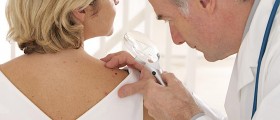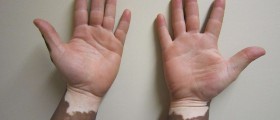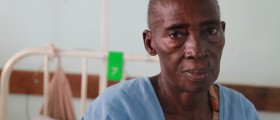
Although it may sound strange human skin is actually the biggest organ in our body. It protects us from damage from different microorganisms, prevents the loss of water and other bodily fluids and also covers and protects organs inside our body. Sweat formed in and on the skin regulates our temperature and expels excess water and salts from the body. The skin also contains numerous sensors for the touch, temperature and pain, thus enabling us to feel these.
Skin Cancer Symptoms
Early detection of skin cancer is extremely important, because it will significantly increase the chances to be completely cured. Skin cancer may be presented as the change of the skin, such as change in the color of a certain spot or growth on the skin. New skin growths and changes in size or color of moles on your body may also indicate skin cancer and these should be reported to your doctor. If the dark pigmentation of the mole starts spreading to the skin around the mole itself this is also something that might indicate skin cancer and therefore requires consultation with the doctor. Bump or nodule on the skin that starts to ooze, bleed, change or become scaly is also something that must be properly checked and diagnosed.
Types of Skin Cancer
Skin cancer is one of the most common of all cancers in the human body, affecting millions of people all over the world. Just in the United States, there are about 2 million of new cases of skin cancer every year. This condition has several types and it could be either non-melanoma or melanoma skin cancer.Non-melanoma skin cancers are more common type of this skin problem and if caught on time, they can be cured. These skin cancers appear on the parts of the body exposed to the sun, such as the neck, face, ears, lips or the back of the hands and they are rarely seen to metastasize to any other part on the body. It affects the basal or squamous cells in the base of the outer layer of the skin.
Melanoma skin cancer is the most severe skin cancer there is. It starts at the melanocytes, cells of the skin responsible for production of skin pigment melanin. Only small number of people affected by skin cancer actually has melanoma skin cancer but it is the most dangerous and potentially lethal skin problem, if left untreated. This cancer is curable if found in early stages of development. About 91% of people diagnosed with melanoma survive for at least 5 years after the diagnosis, while even more than that (98%) survives localized melanoma for more than 5 years. Patients usually see the doctor when the melanoma is localized, so the prognosis is quite good. For people with melanoma diagnosed to be regional there are about 62% chances for 5 year survival, while the patients diagnosed with melanoma in distant stage have 15% chances to survive for that time.Risk Factors for Skin Cancer
People should be aware that exposure to ultraviolet (UV) radiation without proper protection or for a long period of time is considered to be a risk factor for development of skin cancers. People of fair complexion and someone who had serious sunburns as a child or several or atypical moles, as well as family history of skin cancers are also risk factors. Exposure to pitch, arsenic, radium, creosote and coal tar could also provoke greater risk of skin cancers.

















Your thoughts on this
Loading...